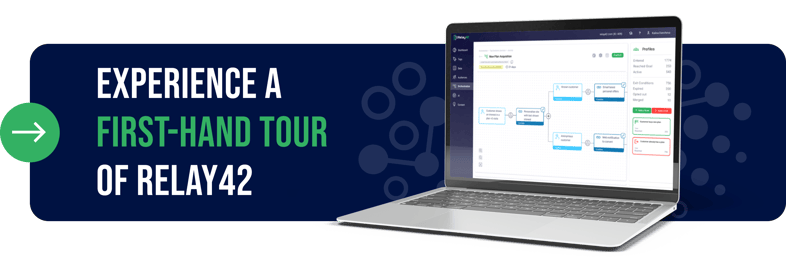Everything You Need to Know About Match Rates
by Kalina Dancheva on 15.10.2020

It's late 2020 and the death of 3rd party cookies is near, yet we're still discussing match rates. The conversation about match rates isn't new — it's been a hot topic since marketers started to understand the power of data and how to best utilize this new gold.
As you can imagine, this makes match rates an important topic for most brands when choosing a new Martech vendor. Marketers are requesting match rate reports as a means of benchmarking and comparing Martech platforms in the same way they wanted click-through rates from ad networks just a few years ago.
So, what do we mean by match rates?
Put simply, a match rate is how many individuals from one data set can be matched with individuals from another.
That seems pretty straightforward, however, there is no one magic 'match rate' per brand. When you are matching CRM data to website behavioral data, and DSP cookies to partner website cookies, you are looking at a match rate per paired data set. Some match rates are naturally higher due to higher moments of recognition within one or both of the data sets. But no match rate is ever going to be 100%.
According to Statista, the average person uses about 6.58 connected devices, and that number is only rising as previously analog devices and appliances now come with network connectivity, increasing the amount of data captured per person indefinitely. How can we know it's the same individual logging into the device? Or providing the correct email address, and not some fake one?
Next to the various devices, every consumer carries about 12 different user identifiers such as CRM IDs, an ever-changing number of cookies picked up in browsers, a couple of brand loyalty numbers and a few hashed email addresses.
There are some factors that are out of our control, such as a wife logging in with her husband's details to check a utilities bill. Technology cannot guarantee consumers will act as we want them to, which means that simply due to the nature of what we are trying to do no vendor can guarantee 100% accuracy across match rates.
How does match rate impact your marketers and service professionals?
In order to tell your customers and prospects a sequential, consistent story across all of these devices, channels, and touchpoints, brands must be able to link their identities to a single customer view. At that point, brands must be able to identify their customers and prospects and match their IDs across these places — with the ambition to maximize match rates.
What causes discrepancies?
Here are a few things to keep in mind when it comes to understanding your match rates, and why it's important to know what you're comparing.
Comparing apples and oranges: Ask yourself what identifiers are being matched. Are we talking about data onboarding (matching offline IDs to cookies) or are we talking about cookie matching (mapping different cookie IDs in a matching table)?
Data onboarding is where we speak about the technical process of uploading and matching offline customer data into the online world, matching them with digital identifiers. In today's world of identity-driven marketing, the critical capability to close the loop between online and offline is now more important than ever.
Cookie matching, on the other hand, is the process by which an advertiser or martech vendor associates cookies in their domain with cookies in the DSP's domain.
Different reporting criteria:
- Live campaign vs. active cookies: Some DSPs will only report on cookies that can be associated with a live campaign, where others will show only those cookies in their reporting that have been seen in a past campaign, which implies brand new users directly from the client website won't be accounted for unless there is an overlap with a previous report.
- Total time to live (TTL): The lifetime of a cookie. Some Martech vendors set the TTL to 180 days while some activation platforms (e.g. DSPs) set it at 30 days. ITP also affects TTL, reducing cookie lifetime to 7 days or even 24 hours in some cases. Variations in the TTL across solutions will certainly impact the parts of your Martech ecosystem that will either count or ignore certain cookies.
- Reporting timeframes: If we go back to the ancient history of audience activation between a data management platform and a DSP, the principle was based on sending a batch of cookies to the DSP, then the DSP ingesting that data and after some time, reporting on it. DSP reporting takes time, sometimes 2–3 days, so comparing the numbers in a real-time customer data management solution on September 1st with the numbers in the DSP on the same day makes little sense.
Many marketers and technology companies still judge their partners and vendors based on how well they can match their customer data (e.g. data warehouse, CRM, etc.) with online users when, while this match rate is important, the focus should be on the quality of the profiles being built, and not just the ability to match IDs.
Without a good identity management resolution, brands cannot identify individuals to deliver a personalized customer experience.
Identity resolution and match rates
Now that we have looked at a few reasons why you should be careful when a vendor is promising 90%+ match rates, let us take a look at what makes a solid identity resolution solution and how to determine whether a particular vendor is going to work for you.
To engage with both customers and prospects in an individualized way, brands need to:
- Capture all of these identifiers and interaction data points
- Connect them to build holistic profiles
- Leverage them to activate each individual with messaging relevant to their personal interest
And all of that needs to happen in real time.
You can ask for a vendor's average match rate when onboarding offline data to their online data, but what are you actually asking for and what does this number mean to you and your brand?
The match rate that reports on the number of records from a brand's customer data (e.g. CRM, data warehouse, etc.) that can be matched to online users will differ per brand depending on:
- The accuracy of their customer data
- The number of identification moments on their brand's online assets
This will differ per brand and per industry so it may not provide you with the relevant information you need to see what will work best for your organization. The more relevant questions to ask when selecting a vendor that will help you to maximize your match rates are:
1. Does the identity resolution solution provide a persistent identity?
People-based marketing requires a flexible, yet solid approach when it comes to managing your customers and prospects identifiers. Brands need to identify their customers and prospects and the digital footprint they leave behind in real-time, all of the time.
They must not only be able to react, but constantly surprise (prospective) customers no matter which touchpoint they choose to use, and they must provide consistent messaging along the entire customer journey.
This isn’t possible if your customer profiles are tied to decaying third-party cookies, or if you are looking at identity as an isolated topic on a campaign-by-campaign basis.
Relay42's Identity Resolution solution isn’t dependent on cookies because we know they expire and can be deleted. Instead, Relay42 can utilize any identifiers to create, build and match profiles over time that are always on and ready for activation. As new devices or channels arise, you have a future-proof solution, as Relay42 provides the flexibility to add new identifiers over time.
2. Does your Martech vendor power real-time connectivity end-to-end?
Engaging with your customers and prospects with the right message at the right time and in the right place is only possible if brands have real-time technology for unifying, matching and activating data within seconds. Without this capability, you lose the opportunity to engage at a critical point in the customer journey in a relevant way. As a result, you miss opportunities to guide them to convert, and more importantly to build a meaningful relationship.
Relay42 is a single platform solution that was built from the ground up. This means that all capabilities work seamlessly together in real time with no loss in data or granularity. This way, you can be truly personal and relevant at each moment along the customer journey, on all of your touchpoints both online and offline.
3. Does the identity resolution provide you with an accurate scale?
A deterministic approach has the distinct advantage of providing highly accurate identification. It’s the gold standard – the difference between knowing and assuming. When you are ready to implement strategies such as personalized pricing and personalized product bundles you want to be as close to 100% as possible when identifying and merging profiles.
At Relay42, we use a deterministic approach and our brands are able to define which identifiers they want to use and the scenarios in which merging should take place e.g. via log-in, conversion, email click-through etc.
Common identifiers include (hashed) email, (hashed) phone, social ID, 2nd party cookies, 1st party cookies, CRM identifier etc. Setting up a brand's identity management plan is a standard part of the Relay42 onboarding and can be adjusted over time to evolve with your customers and any new potential identification moments.
4. Who owns and controls your profiles and data?
Identity resolution is a strategic asset that should be owned and controlled by your brand. It is, after all, the foundation of how you will collect and store data in relation to an individual. When the brand owns the Identity graph, they get a full view of the customer journey and remain in full control of their data.
Every customer and prospect interaction on any touchpoint and in any campaign can be used to personalize the customer journey end-to-end, and of course, to build rich, holistic profiles of both your customers and prospects.
With Relay42, ownership of the data and your identity resolution strategy always resides “inside” the brand rather than with the vendor or walled garden. With Relay42, your identity resolution strategy can be used continuously to close the loop between all of your customer touchpoints, and your marketing and technology partners within your ecosystem.
5. How does the vendor help you to increase your match rates?
Aside from the technology itself, does the vendor provide guidance on how to define your Identity Resolution strategy? Do they proactively work with you to increase match rates by looking for new potential, mutually beneficial, identification moments? This means that the users offer up some type of identifier in return for something useful e.g. a newsletter sign-up, a price alert, an online call back.
Let’s say the vendor quotes an average of 90%+ match rates on data onboarding, but only manages to achieve about 20% with your customer data. This could be due to a number of factors, and one that is out of the vendor's control is your customer data quality.
The most important question is how are they going to help you? No magic solution can fix this on its own. How is the vendor going to help you to increase your match rates and thus help you to grow high-quality first-party data?
At Relay42, we proactively work with our customers to increase match rates. This is a joint ongoing project geared towards collecting more (non-cookie) identifiers by increasing identification moments with various strategies. As mentioned, we believe in doing this in a mutually beneficial way.
When you request data from a customer you should be giving them something of value in return. We implement use cases primarily focused on these types of configurations, collecting identifiers (while providing value to the customer) and increasing match rates to help the brand grow their rich, first-party data.
You May Also Like
These Related Stories

3 Powerful Use Cases to Restart Airline Digital Marketing

Respectful Marketing in the Cookieless World: 3 Steps to Get Started



